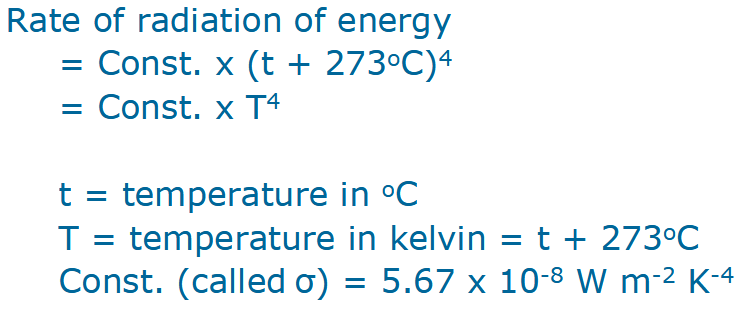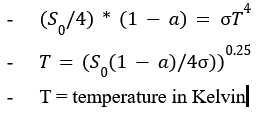Lecture 9 The Earth's Climate and Other Planets
1/17
There's no tags or description
Looks like no tags are added yet.
Name | Mastery | Learn | Test | Matching | Spaced |
|---|
No study sessions yet.
18 Terms
Temperature Definition
determines which way heat flows and represents the amount of heat a body contains, for this lecture climate is temperature
Heat (Energy) Definition
the quantity of energy required to give an object its temperature (J)
(Heat) Flow/Flux Definition
the rate of energy transfer (between objects) [Js-1=W], possibly per unit area [Wm-2]
(1) Simplest Model for Earth’s Average Temperature
heat in -> T -> heat out (depending on T)
heat in and out balance
a simple energy balance model, equilibrium or ‘steady state’ model = no dependence on time

Temperature of a Planet Based only on Heating (5)
simple model for Earth’s average temperature
heating by incident sunlight
intrinsic brightness of the sun and distance from sun matter
1/r2
consider energy from sun
1361Wm-2 if face on
but, half of Earth is in shadow, most of the day surface is obliquely lit, reduces intensity by factor 4 on average
Heat in = S0/4 = 340Wm^-2
albedo
so, what determines temperature of a plant?
power of incident sunlight (340Wm-2)
albedo of the planet (0.3)
net power absorbed = 340 x (1-0.3) = 340 x 0.7 = 238Wm-2
but if there were only heating, the planet would get hotter and hotter
but, Earth radiates heat
Total Solar Irradiance
total energy/metre squared/second received by Earth’s orbit

Average Flux Density
total power that strikes Earth passes through blue area A=R^2
power is then spread over whole earth, with A=4R^2
so, average flux density received by Earth’s surface is S0/4

Albedo
on average Earth reflects about 30% of insolation back into space
largely from clouds
Sun and Earth Temperatures
Sun’s temperature is 6000K
emits radiation at visible wavelengths
Earth’s temperature is ~255K
emits radiation at infrared wavelengths
Thermal Radiation of Earth
rate of radiation of energy
=Const. * (t+273C)^4
=Const. * T^4
t = temperature in celsius
T = temperature in Kelvin = t + 273C
Const. =5.67 * 10-8Wm^-2K^-4
fourth-power law is very rapid rise
if T increases by 1%, radiation increases by 4%
if T doubles, radiation increases to x16

(2) Equilibrium: Temperature of the Earth considering heating and cooling
both heating (power of incident sunlight and albedo) and cooling (power radiated, depends on planetary temperature)
new recipe for planetary temperature
calculate solar heating S0 at planet using distance from Sun =S0/4
multiply this by (1-albedo) to get radiation flux INTO climate system
find the temperature that gives a matching flux out using
Constx * (t+273C)4
dynamic equilibrium
point where radiation in and radiation out balance depending on t
new energy balance model
(S0/4)*(1-a)=T4
T=(S0(1-a)/4))0.25
T = temperature in Kelvin

Calculating Temperature using Equilibrium Model
(340Wm-2)*(1-03) = (5.67*10-8Wm-2K-4)*T4
T4=(340Wm-2/5.67*10-8Wm-2K-4) 8 0.7
T4=4.20*109K4
T=254.5K or t=-18.5C
graph of planetary temperature vs distance from sun varied by albedo
Predicted planetary temperatures in Celsius
Venus: -46 -> 462
Earth: -18 -> 15
Mars: -57 -> -60
Enceladus: -213 -> -205
very poor predictions for Venus and Earth -> why?
Greenhouse Effect!
Importance of Atmosphere
Mars has almost no atmosphere
volume 1% of Earth’s
Enceladus has no atmosphere
Earth and Venus do have atmosphere
Venus’s is 90 times that of Earth’s mass-wise and is mostly CO2
where is outgoing energy coming from?
Where is outgoing energy coming from in the atmosphere?
top of atmosphere receives S0/4=340Wm-2 on average
about 30% of this is reflected back into space = the albedo
the remaining 70% is absorbed by the ground and the atmosphere
the atmosphere and clouds reflect, absorb, and reradiate radiation
the amount of outgoing energy is characteristic of the temperature of the atmosphere and clouds at ~5.5 km
Natural Greenhouse Effect
environmental lapse rate ~-6C per km in troposphere(up until 10km)
h = height, L = lapse rate
radiative cooling to space comes on average from about 5.5km, fixing the mean temperature at this height
(3) Final Climate Model with Atmospheric Impact (6)
T=(S0(1-a)/(4))0.25+hL
one output -> global mean surface temperature
one fundamental constant -> radiation constant =5.67 * 10-8Wm-2K-4
four parameters -> solar constant, albedo, mean source height of outgoing radiation, atmosphere lapse rate
S0=1360Wm2, a=0.3, h=5.5km, L=6Kkm-1
T=254.2K+22.0K=287.5K=14.5C

Timescales (6)
in the climate practical you will consider
Earth’s albedo changes
Solar activity changes
the energy balance changes and so the temperature changes
the oceans cover most of the Earth’s surface
the oceans take time to respond to the change in energy balance and hence for the surface temperature to change
the whole ocean takes a long time to respond
the mixed layer (first 20m) responds much faster
Oceans and Absorption of Sunlight
most radiation absorbed near the surface in the mixed layer, before the thermocline
heat mixed to about 100m